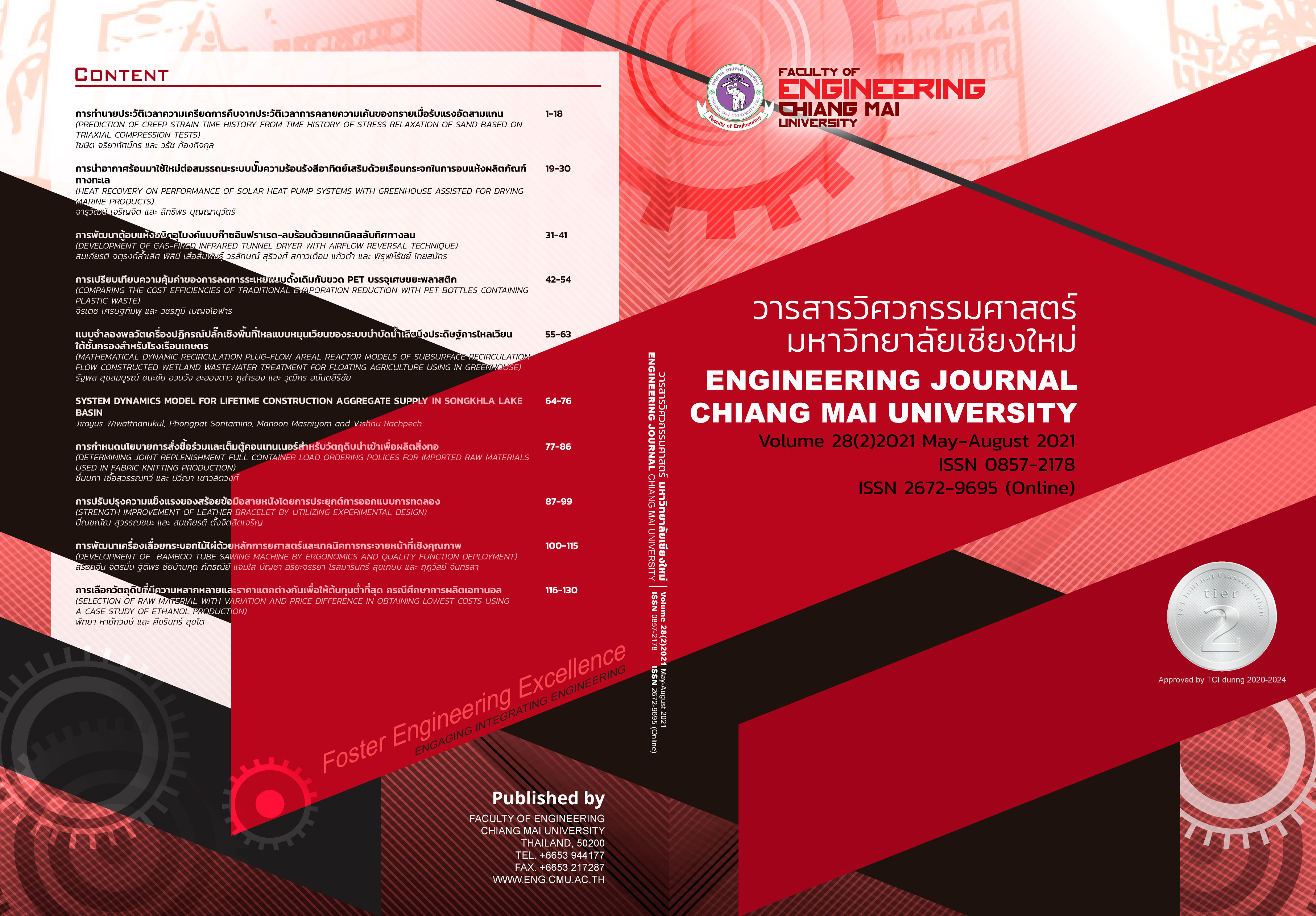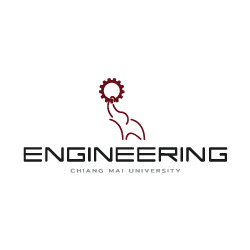การเลือกวัตถุดิบที่มีความหลากหลายและราคาแตกต่างกันเพื่อให้ต้นทุนต่ำที่สุด กรณีศึกษาการผลิตเอทานอล
คำสำคัญ:
การพยาการณ์อนุกรมเวลา, วิธีบ็อก-เจนกินส์, การผลิตเอทานอล, การเลือกวัตถุดิบ, กระบวนการตัดสินใจบทคัดย่อ
งานวิจัยนี้มีวัตถุประสงค์เพื่อการเลือกวัตถุดิบจากโรงงานน้ำตาลที่มีความหลากหลายและมีความแตกต่างกันด้านราคา คุณภาพและปริมาณ ซึ่งทำให้ต้นทุนด้านวัตถุดิบสำหรับการผลิตเอทานอลที่ต่ำสุด ด้วยการศึกษาปัจจัยทางทฤษฎีการเปลี่ยนน้ำตาลเป็นเอทานอล การรวบรวมข้อมูลคุณภาพวัตถุดิบ ราคาสัญญากากน้ำตาล C และการคาดการณ์ราคาน้ำตาลตลาดโลกด้วยการพยาการณ์อนุกรมเวลาตัวแบบ Box-Jenkin’s (Auto-Regressive Integrated Moving Average; ARIMA) เพื่อนำมาวิเคราะห์หาต้นทุนด้านวัตถุดิบที่ต่ำที่สุด ผลการวิจัยสรุปได้ว่าการพยากรณ์ด้วยตัวแบบ ARIMA(1,2,1) นั้น พบว่าราคาน้ำตาลตลาดโลกในเดือนกรกฎาคม พ.ศ. 2564 ปรับตัวสูงขึ้นเป็น 12,131 บาทต่อตันหรือ 17.75 เซนต์ต่อปอนด์ ส่งผลให้วัตถุดิบที่มีสัดส่วนของน้ำตาลในวัตถุดิบมีราคาสูงขึ้นอย่างมีนัยสำคัญ จากนั้นเข้าสู่กระบวนการเลือกวัตถุดิบอย่างมีขั้นตอน โดยการหาสัดส่วนน้ำตาลและกากน้ำตาลในวัตถุดิบ ด้วยสมการ SJM Formula จากนั้นทำการวิเคราะห์ต้นทุนวัตถุดิบแต่ละชนิด เพื่อจัดเรียงลำดับต้นทุนและปริมาณวัตถุดิบให้สอดคล้องกับความต้องการของลูกค้า ดังนั้นการเลือกใช้น้ำเชื่อมในช่วงฤดูกาลการผลิตของโรงงานน้ำตาล เข้าสู่กระบวนการผลิตจะช่วยลดการนำเข้ากากน้ำตาลจากต่างประเทศและไม่นำกากน้ำตาล B ที่มีต้นทุนสูงเข้าสู่กระบวนการผลิตเอทานอล ซึ่งจะทำให้ต้นทุนรวมต่ำที่สุดเมื่อเทียบกับกรณีอื่น ๆ จากสถานการณ์จำลองสามารถลดต้นทุนด้านวัตถุดิบได้ 3.14% หรือประมาณ 94.7 ล้านบาทต่อปี
References
Arshad, M., Abbas, M. and Iqbal, M. (2019). Ethanol production from molasses: Environmental and socioeconomic prospects in Pakistan: Feasibility and economic analysis, Environmental Technology and Innovation, vol. 14, February 2019, pp. 100317
Naik, S. N. et al. (2010). Production of first- and second-generation biofuels: A comprehensive review, Renewable and Sustainable Energy Reviews, vol. 14(2), October 2009, pp. 578–597.
García-Bustamante, C. A. et al. (2018). Development of indicators for the sustainability of the sugar industry, Environmental and Socio-Economic Studies, vol. 6(4), November 2018, pp. 22–38.
Ihwah, A. and Viandini, U. H. (2020). Forecasting of purchasing quantity of Manalagi apple for apple juice drink production in PT XYZ Malang, IOP Conference Series: Earth and Environmental Science, vol. 475(012054), International Conference on Green Agro-industry and Bioeconomy
Bhatti, Z. A., Rajput, M.-H. and Maitlo, G. (2019). Impact of Storage Time, Rain and Quality of Molasses in the Production of Bioethanol, Mehran University Research Journal of Engineering and Technology, vol. 38(4), October 2019, pp. 1021–1032.
Zhang, P. G. (2003). Time series forecasting using a hybrid ARIMA and neural network model, Neurocomputing, vol. 50, November 2001, pp. 159–175.
Wright, P. G., Fernandes, A. C., and Zarpelon, F. (2007). Control Calculations for Factories Producing Both Sugar and Alcohol, Proc. Aust. Soc. Sugar Cane Technol, vol. 29(1-13).
Borges, E. P. et al. (2015). The benefits of applied research: 37 years of discoveries, adaptations and solutions, Sugar Industry, vol. 6, April 2015, pp. 209–216.
Ahmad, S. et al. (2019). Study of morphological and qualitative plant traits against the infestation of chilo infuscatellus L. (pyralidae, lepidopetra), Applied Ecology and Environmental Research, vol. 17(3), April 2019, pp. 7057–7065.
อี้หงส์ โง้ว และวิเชียร กิจปรีชาวนิช. กระบวนการผลิตเอทานอลจากโมลาส, สำนักพิมพ์มหาวิทยาลัยเกษตรศาสตร์, 2560
Matyjaszek, M. et al. (2019). Forecasting coking coal prices by means of ARIMA models and neural networks, considering the transgenic time series theory, Resources Policy. Elsevier Ltd, vol. 61, December 2018, pp. 283–292.
Sujjaviriyasup, T. and Pitiruek, K. (2018). A comparison between MODWT-SVM-DE hybrid model and ARIMA model in forecasting primary energy consumptions, IEEE International Conference on Industrial Engineering and Engineering Management, December 2017, pp. 799–802.
Işığıçok, E., Öz, R. and Tarkun, S. (2007). Forecasting and Technical Comparison of Inflation in Turkey with Box-Jenkins (ARIMA) Models and the Artificial Neural Network, International Journal of Energy Optimization and Engineering, vol. 9(4), October 2020, pp. 84–103.
กรินทร์ กาญทนานนท์. การพยากรณ์ทางสถิติ. ซีเอ็ดยูเคชั่น, 2561 หน้า 147-173.
Chiewchanchairat, K., Bumroongsri, P. and Kheawhom, S. (2013). Role of hybrid forecasting techniques for transportation planning of broiler meat under uncertain demand in thailand, KKU Engineering Journal, vol. 40, March 2015, pp. 131–138.
Harlianingtyas, I., Salim, A., Hartatie, D., & Supriyadi, S. (2020). Forecasting sugarcane production in the Asembagus sugar factory, IOP Conference Series: Earth and Environmental Science, vol. 411(1), January 2020.
Kwon, H., Do, T. N. and Kim, J. (2020). Comprehensive Decision Framework Combining Price Prediction and Production-Planning Models for Strategic Operation of a Petrochemical Industry, Industrial and Engineering Chemistry Research, vol. 59(25), June 2020, pp. 11610-11620.
Mandade, P. and Shastri, Y. (2019). Multi-objective optimization of lignocellulosic feedstock selection for ethanol production in India, Journal of Cleaner Production, vol. 231, May 2019, pp. 1226-1234.
Thulasizwe T. Ngwenya. (2012). An industrial perspective of factors affecting molasses fermentation by Saccharomyces cerevisiae, Journal of Brewing and Distilling, vol. 3(2), March 2012, pp. 23–28.
US Sugar #11 Futures, United States (2021). Statistic Data, available online: https://th.investing.com/commodities/us-sugar-no11
บริษัท มิตรผลวิจัยพัฒนาอ้อยและน้ำตาลจำกัด (2556). รายงานโครงการศึกษาอุณหภูมิที่มีผลต่อการเสื่อมคุณภาพของกากน้าตาลในระหว่างจัดเก็บ, รายงานโครงการศึกษาอุณหภูมิที่มีผลต่อการเสื่อมคุณภาพของกากน้ำตาลในระหว่างจัดเก็บ, หน้า 9 – 1
Downloads
เผยแพร่แล้ว
ฉบับ
บท
License
ลิขสิทธิ์ของบทความที่ตีพิมพ์ในวารสารฉบับนี้จะยังเป็นของผู้แต่งและยินยอมให้สิทธิ์เผยแพร่กับทางวารสาร
การเผยแพร่ในระบบวารสารแบบเปิดนี้ บทความจะสามารถนำไปใช้ได้ฟรีในการศึกษา และในทางที่ไม่เกี่ยวกับการค้า



